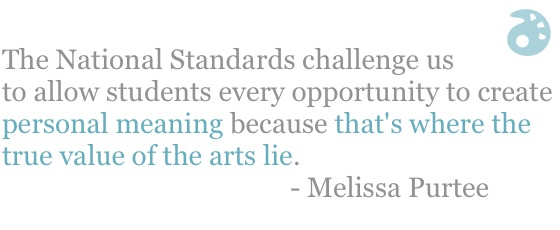The Elements and Principles of Art are important, foundational material for any good visual arts curriculum. Many art teachers know this to be true. Some of us base units around concepts like repetition and symmetry. We teach students to recognize the different types of balance and unity. Many art teachers describe them as “essential knowledge” or our “common visual language” while others view them as less important. So, how should the Elements and Principles, E&Ps for short, be used in our classrooms?

To decide what to teach, many of us start with reviewing the standards. Unfortunately, that’s not much help because the E&Ps are completely missing from the revised National Arts Standards.
Instead, let’s look at what the standards do ask us to teach.
The Big Picture
Olivia Gude, a member of the standards writing team, said, “The Next Generation Visual Arts standards are focused on student choice and on students making personally meaningful works of art and design.” She went on to add, “Standards in the Respond section affirm that students will use their knowledge about art and images to understand the various perspectives of other people and then to make their own interpretations based on their art knowledge and life experiences.”
The focus of the National Standards isn’t on specifics. Instead, attention is given to big-picture concepts that are essential to the teaching of art, like creating personalized meaning through making work, interpreting art subjectively and applying personal context to make connections. The E&Ps might be important as part of the teaching of art-specific vocabulary, but they are a supporting element of the curriculum, not the focus. If you are basing whole units or even entire lessons to the E&Ps, you may be overemphasizing them and possibly missing out on other important content.

So, What Should We Teach?
Here are some general guidelines for teachers interested in incorporating the Elements and Principles as a support to the big ideas of the National Standards.
- Instead of basing lessons on specific Elements and Principles, base lessons on themes that students can connect to in a personal way.
- When analyzing works of art, ask students to make personal or cultural connections to the work in addition to addressing the work’s formal qualities. Or, let students decide how to respond by asking them what stands out for them when they see the work.
- Give students opportunities to respond to artwork by interpreting its meaning through work of their own that provides at least a moderate level of choice. For example, if you show and discuss Starry Night with a group, one student might decide to use thick, linear paint application while another might experiment with arbitrary color and a third could draw a night landscape they remember from experience. All these responses are personal and valid —why pick for them?
- Consider expanding your definition of the language of art beyond the E&Ps to include Postmodern Principles, theme-based lines of inquiry and personal or emotional response to artwork.
The Takeaway
Basing lessons and art criticism on the E&Ps can be tempting. They are, after all, a known and identifiable quantity. That’s a big strength in the age of assessment and the reason for their inclusion in state and local standards. The problem is that art is not quantitative, it’s personal and subjective. When we try to standardize our responses to artwork we lose opportunity for meaning. The National Standards challenge us to allow students every opportunity to create personal meaning because that’s where the true value of the arts lie.

The Elements and Principles describe art verbally, but what about impressions, personal connections, and emotional responses? The E&Ps only have value if they are used to support the development of personalized responses to work. If they are used in place of this then, yes, they are a crutch. However, including them, if a teacher is so inclined, can be an important part of building art-specific language. The bottom line is that we need to focus on the goal of teaching students to make meaningful art.
How do you feel about the E&Ps? Do you love them? Hate them? Feel indifferent?
What are your thoughts about using the E&Ps vs. different strategies to develop lessons?
Magazine articles and podcasts are opinions of professional education contributors and do not necessarily represent the position of the Art of Education University (AOEU) or its academic offerings. Contributors use terms in the way they are most often talked about in the scope of their educational experiences.




